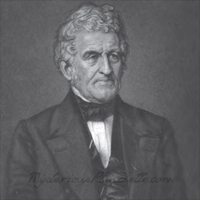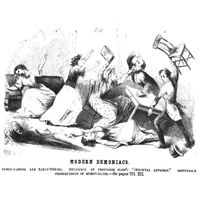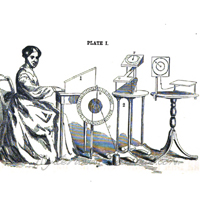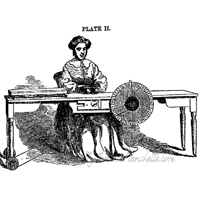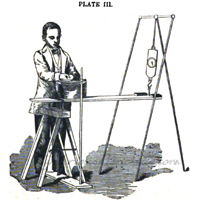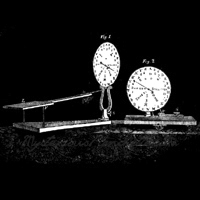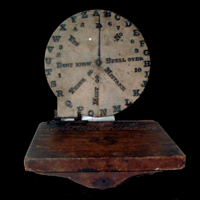Professor Robert Hare was among the world's most eminent scientists until his public support of Spiritualism led to a spectacular fall from grace. Hare was a prominent chemist and inventor, as well as a prolific author on all manner of subjects. In the mid-1850s, he set out to utterly dismantle in the swelling tide of belief in spirit communication and growing army of rapping mediums, only to find him himself convinced of the veracity of the subjects he was testing. His public coming out took place in a series of letters to prominent Episcopal ministers and a book entitled "Experimental Investigation of the Spirit Manifestations," and led to the scientific community largely shunning the aged professor.
Within his book's pages, he described his first doubts and public denunciations, and the invitations he received from rapping mediums who wished to demonstrate abilities that they maintained were true. In several subsequent sittings with these mediums, Dr. Hare's steadfast opposition began to waver as he experienced their startling revelations into matters about which he claimed they could not possibly have had prior knowledge. It was among the first of many such accounts that would ensnare prominent men of science during Spiritualism's heyday. Dr. Hare, as scientists do, wished to further investigate the abilities of these mediums and subject them to strict test conditions in order to see if the spirit communications remained true. To facilitate this, Dr. Hare constructed a series of devious contraptions designed to test the medium's capabilities, which he collectively called "Spiritoscopes". The results of his experiments would end in a total reversal of his beliefs and solidify his commitment to the truth of spirit communication.
The Spiritoscopes constructed by Dr. Hare vary in form and complication, but are fascinating examples of the scientific spirit-no pun intended. We are extremely fortunate that the good professor took photographs of his devices. While the original photos have yet to be rediscovered, they were translated into engravings for his book, and from that we cannot only witness firsthand his ingenuity for creating test conditions for spirit communication, but also reconstruct the appearance of the Isaac Pease "Spiritual Telegraph Dials" he used to construct many of his devices.
The first plate in his book displays 3 Spiritoscopes. Hare's stated goal was to determine "whether the manifestations attributed to spirits could be made without mortal aid," but curiously, all the devices are designed to be used by mediums. We can only surmise that even with his skepticism, the professor still believed that spirit communications could only be passed through a mortal agent. His inventions were constructed to keep those agents as honest as possible, though in his writings, Dr. Hare also doesn't discount that the mediums might employ clairvoyant abilities that would allow them to cheat. The professor apparently had an open mind, but we also can't discount that he was 72 years old at the beginning of these tests, with possibly hindered senses, making him an easy target for deceptive mediums.
The first device built by Hare was a means of testing table-tipping mediums. Typically in such seances, letters would be called out, and the table's legs would rap sharply when the spirit's desired letter was called for, with messages being slowly formed. Dr. Hare's device utilized a small writing desk, to which was affixed a large wheel carrying an alphabet, whose face was shielded from the medium's sight by a screen. When the table was tipped or tilted, a series of pulleys and counterweights would cause the dial to turn, with an iron rod acting as a pointer to select letters chosen by the spirits. Despite the blind nature of the test, the mediums were apparently successful in fostering convincing spirit communications.
The other two devices shown in Plate I are special to researchers, because they employ "Spiritual Telegraph Dials" constructed by Isaac Pease, from whom Hare purchased several. Dr. Hare incorporated Pease's dial plates into at least 3 of his Spiritoscopes, and it is only through these depictions and his descriptions of them that we know what they looked like. The Pease dial plates would normally be used in a medium's hands, where an ideomotor tilting action would cause the device's pointer to fall on letters obstinately selected by the spirits. This direct influence would not do for the purposes of Hare's scientific investigations, and as a result, he instead rigged up complicated contraptions using pulleys, wire, and counterweights, in order to remove mediums' direct interaction with the device. One device used an angled fulcum lever made of wooden slats and posts, with the fulcrum wired to the index pointer of the dial plate. This supposedly still allowed for physical mediumistic contact, but was thought to be a more honest application of the spirit's abilities, it being thought that where precise messaging would be too difficult for a human subject, the spirits would take up the slack. A second featured device was similar, and made to be more portable, again utilizing a Pease dial plate, but with a simpler handplate and tension wire, as well as clamps that allowed the contraption to be set up on any table. No devices featured in Plate I have been rediscovered.
Plate II of Hare's book features his largest test apparatus, designed to test the spirit communication properties of table-tipping mediums. Like the Spiritoscopes, it was designed to engage a medium test subject while limiting their direct physical contact with the communication item, in this case an alphabet dial-enabled table. According to Hare's exhaustive description of the item, it was a table, some 6-feet long by 16-inches wide, constructed to be disassembled into 3 pieces for "conveniency of carriage" to the homes of mediums. One set of legs were on normal furniture castors, while the others had larger wheels. Affixed to the table's front, opposite the test subject and facing away from their view, was an alphabet dial, made by Hare this time, rather than Pease, that rotated to selected letter when the table was shifted left of right along its rollers, with the movement of the dial facilitated by a simple pulley. This blind test was not enough for Hare, however, who wanted to demonstrate that the force a medium exerted in table-tipping sessions could be achieved without direct physical contact with the table. Therefore, a sitting medium had to place their hands on a wooden board set atop the table, underneath which there were two round balls. With the medium's hand perched atop this now rolling board, it would be impossible to move the large table horizontally in any fashion without the aid of spiritual influence. Once again, Hare seemed to think that mediums may be able to cheat his device-not by exerting pressure with their legs or other physical fraudulent manipulations-but rather by using clairvoyance to spy the shielded letters. Strange experiments, indeed.
Plate III shows yet another device for measuring the spiritual magnetic force Hare believed mediums were able to channel, this time by isolating the medium's hands in a water pot, and testing the weight they were able to exert on a spring scale set against a fulcrum. This device was not constructed for the conveyance of spirit message, yet Hare still seemed convinced in the ghostly influence spirits had on an 11-year-old test subject who was able to exert 18 pounds of pressure on the scale despite only having his hands in suspended in water.
Plate IV is perhaps the most important to collectors regarding Hare's Spiritoscopes. It features more detailed engravings of the fulcrum model found in Plate I, but also another Spiritoscope not previously discussed. Like the fulcrum device repeated here from Plate I, it is built around a cast iron copy of a Pease dial plate that Hare annotated somewhat, removing a lot of the extraneous phrasing and the music tablature rings.
Similar to the Plate II table, this Spiritoscope's mechanism was based on the back-and-forth horizontal movement of a wheeled wooden hand rest. The medium would sit behind the device so that the front plate was facing away from them, and roll the device back and forth across a table, where the a series of pulleys would rotate the device's pointer, spelling out messages from the spirits. What makes this illustration special is that it depicts the sole surviving Hare Spiritoscope of which we know, discovered at a yard sale some years ago. While the mechanism seems to be missing at least the front wheel, the index is still in place. This is an incredibly exciting find, and we hope that further discoveries turn up more of Professor Hare's fascinating devices. Who knows-maybe those strange marks on your antique kitchen table mean more than you think!







